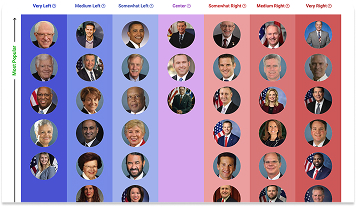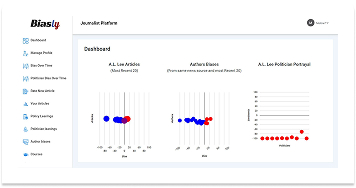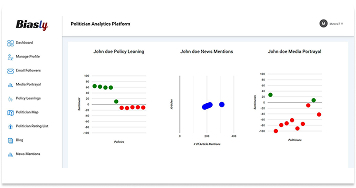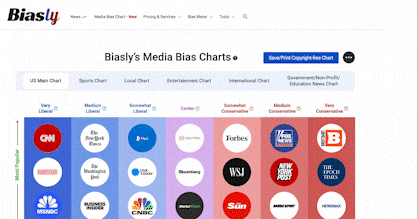Bias Meter
Extremely
Liberal
Very
Liberal
Somewhat Liberal
Center
Somewhat Conservative
Very
Conservative
Extremely
Conservative
-100%
Liberal
100%
Conservative

Biasly determines media bias ratings through a dual-layered approach combining artificial intelligence and analyst review. The platform’s proprietary bias detection engine, Bias Meter, evaluates sentiment, policy position alignment, and language framing across thousands of data points in news articles. Analysts then verify and interpret the AI’s findings, providing additional context where needed. Learn more
- Profile
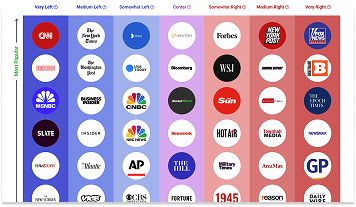
Daily Voice on the media bias chart
Daily Voice has a Bias Score of 14% Somewhat Right which is based on a variety of factors including its policy and politician leanings, article ratings, and the use of biased language. Its Reliability is rated as Average, and additional analytical insights are available in the other tabs.
- Bias Rating
14% Somewhat Right
- ReliabilityPolicy Leanings
12% Somewhat Right
Extremely
LiberalVery
LiberalModerately
LiberalSomewhat Liberal
Center
Somewhat Conservative
Moderately
ConservativeVery
ConservativeExtremely
Conservative-100%
Liberal100%
Conservative
Average Reliability
*Our bias meter rating uses data science including sentiment analysis, machine learning and our proprietary algorithm for determining biases in news articles. Bias scores are on a scale of -100% to 100% with higher negative scores being more liberal and higher positive scores being more conservative and 0% being neutral. The rating is an independent analysis and is not affiliated nor sponsored by the news source or any other organization.
Politician Portrayal41% negative
Continue For Free
Create your free account to see the in-depth bias analytics and more.
By creating an account, you agree to our Terms and Privacy Policy, and subscribe to email updates.
Policy Leanings Analysis
Policy | Bias score |
|---|
Daily Voice Editorial Patterns
Daily Voice’s coverage of political topics often reflects a Somewhat Right bias, with consistent patterns in phrasing, source selection, and thematic focus that are Lean Right. While the publication demonstrates journalistic standards in many of its reports, the choice of issues, framing, and word usage may indicate a political slant. This content analysis examines how Daily Voice handles liberal and conservative issues and evaluates its language choices and editorial tendencies.
Coverage of Liberal vs. Conservative Topics
Daily Voice’s articles cover topics such as politics, local sports, police, and lifestyle, which are very often presented neutrally. Even though some of these topics may be talking points for both the Democratic and Republican parties, they are presented without any bias. For instance, coverage of topics relating to politics and the actions of political candidates does not involve any opinionated language. Most situations are reported factually, with opinions expressed only through quoted sources.
Articles covering both conservative and liberal figures often employ a neutral tone. Biasly’s analysis of recent Daily Voice articles reveals a tendency to limit any editorialization and not downplay any party’s beliefs. If there are incidents that affect candidates from either party, they are scrutinized the same way, and the opinion upon these incidents comes from the quotes and/or sources used.
Phrases such as “The victim tells Daily Voice that”, “being remembered by his family” and “noting it is expected to form off the Georgia coast”, appear in articles across Daily Voice’s website. This type of phrasing presents no opinion at all, and is what Daily Voice has become known for to its daily readers.
Policy and Issue Framing
When covering politics, Daily Voice often references scandals surrounding politicians or inflammatory actions. This aligns with their slight Somewhat Right media bias, curiously so in the Northeast, where local culture tends to be more liberal. Similarly, coverage of business reflects a neutrality not often seen among news sources today, with its journalists explaining the situation with as little editorialization as possible. Politicians and scientists are regularly quoted when the article calls for it. When it is an article covering local news, there are typically quotes from the people involved in that situation.
Hot-seat issues like prison sentences, border security, or systemic racism — typically points that each party has very strong stances on — are also still covered without any heavy bias. Though on rare occasions these topics are contextualized through their impact on marginalized groups or framed as polarizing, as complete neutrality is rarely achievable. Word choice and image placement may unintentionally contribute to bias in news media.
Coverage and Relevance
Daily Voice’s reporting often touches on key issues central to the political bias discussion, including crime in New England, lifestyle tips, and political commentary within the United States. As such, it serves as a compelling case study for examining source bias and news media bias in local and national reporting.
Readers who wish to further explore how Daily Voice compares with other publications can visit Biasly’s Media Bias Chart to analyze tone and word choice in real time.
Daily Voice Bias Analysis
Daily Voice was founded in 2010 by Carll Tucker. Today, it functions as an outlet to “bridge the news desert between national & hyper-local news”, . Daily Voice positions itself as a community-focused outlet, providing detailed local coverage across New England alongside select national news.
According to Biasly’s bias analysis, Daily Voice reaches an average of 6,366,000 monthly visits. When it comes to media bias, both AI and media analysts have evaluated its content, sources, and funding to determine its political leaning.
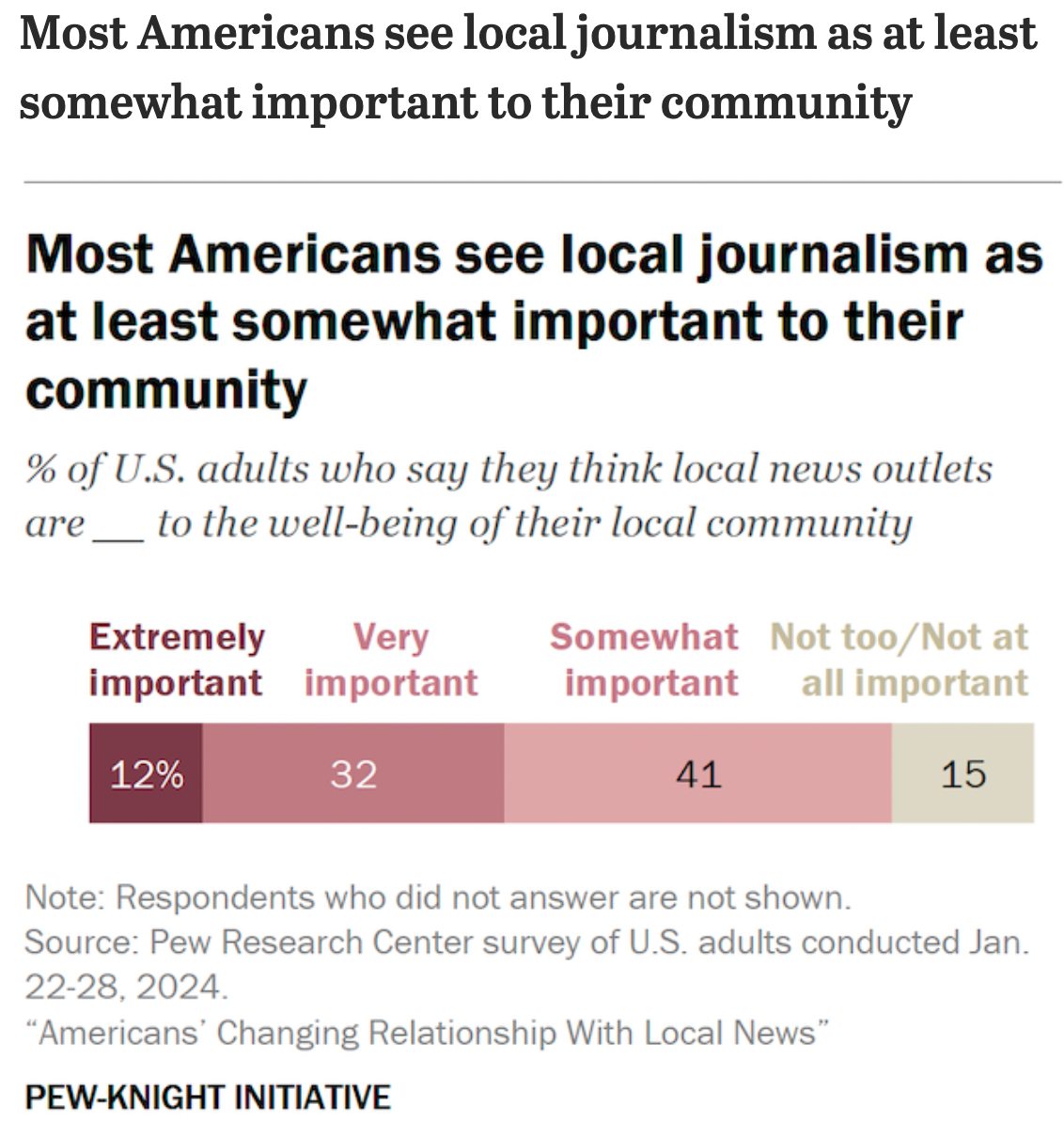
Source: Pew Research
As a leading local media outlet in the New England states, Daily Voice plays a role in shaping public perception. Readers’ trust in local journalism may reflect the conclusions of Biasly’s media bias ratings. This article delves into Daily Voice’s editorial tendencies to explore whether political bias is present and, if so, to what degree.
Is Daily Voice Biased?
Based on Biasly’s evaluations, Daily Voice is rated as Somewhat Right.
By examining content patterns and the broader context of media influence, we aim to offer a balanced perspective on Daily Voice’s political bias, and contribute to the ongoing discussion about bias in the news.
How Does Biasly Rate News Sources?
Biasly uses proprietary algorithms and a team of analysts to provide comprehensive bias evaluations across thousands of news outlets. Over 200,000 articles from more than 3,200 sources have been analyzed to identify the most accurate and unbiased stories.
Biasly assigns each outlet three key scores:
- Reliability Score – Reflects factual accuracy
- AI Bias Score – Generated via natural language processing
- Analyst Bias Score – Assessed by human political analysts
These scores are based on seven core metrics: Tone, Tendency, Diction, Author Check, Selection/Omission, Expediency Bias, and Accuracy. These elements help analysts and algorithms evaluate the political attitude conveyed by each article.
Biasly’s Bias Meter ranges from -100% (most left) to +100% (most right), with 0% indicating neutrality. The system evaluates individual articles based on political terms, policies, figures, and sentiment to calculate precise bias ratings.
Is Daily Voice Politically Biased?
Daily Voice earns a Somewhat Right rating for its AI Bias Score and a Somewhat Right for its Analyst Bias Score. The Analyst Bias Score is generated by reviewers from liberal, moderate, and conservative backgrounds. Analysts reviewed Daily Voice articles and noted preferences in areas like coverage of local news and some issues at the national level. However, the paper maintains objectivity on the vast majority of its topics, whether they are local or not.
For example, coverage of racial minorities and affirmative action laws, which often elicit opinionated reporting elsewhere, is presented factually. Occasionally, certain articles display slightly stronger right-leaning tendencies, which contribute to Daily Voice’s Somewhat Right rating.
The demography of the New England states presents a contrasting backdrop. All of the New England states have consistently voted for the democratic party in Presidential elections since 2000, according to 270ToWin. This does not align entirely with Daily Voice’s bias rating, which falls relatively close to the center with a Somewhat Right bias.
This means the New England states lean more liberal, which could explain differing perceptions of Daily Voice’s content. The paper may draw mixed reactions depending on readers’ political orientations.
This Bias score is determined through natural language processing that evaluates the tone, word choice, and opinion embedded in the reporting.
Analysis of Bias in Daily Voice Online Articles
Daily Voice has found that in-depth coverage of local news in New England states and in the wider United States is one of the most effective ways to drive their viewership up. Given that much of its readership is New England-based, where regional issues are highly important, it’s essential to ask: is Daily Voice truly biased?
To evaluate this, we can analyze select Daily Voice articles through several of Biasly’s bias rating criteria: Tone, Tendency, Author, Diction, and Expediency Bias.
- Tone: The overall attitude conveyed by the article
- Diction: Specific word choices made by the writer
- Author: The background and social presence of the journalist
- Tendency: Patterns of bias in the writer’s broader body of work
- Expediency Bias: Quick visual or textual indicators like headlines and photos that imply bias
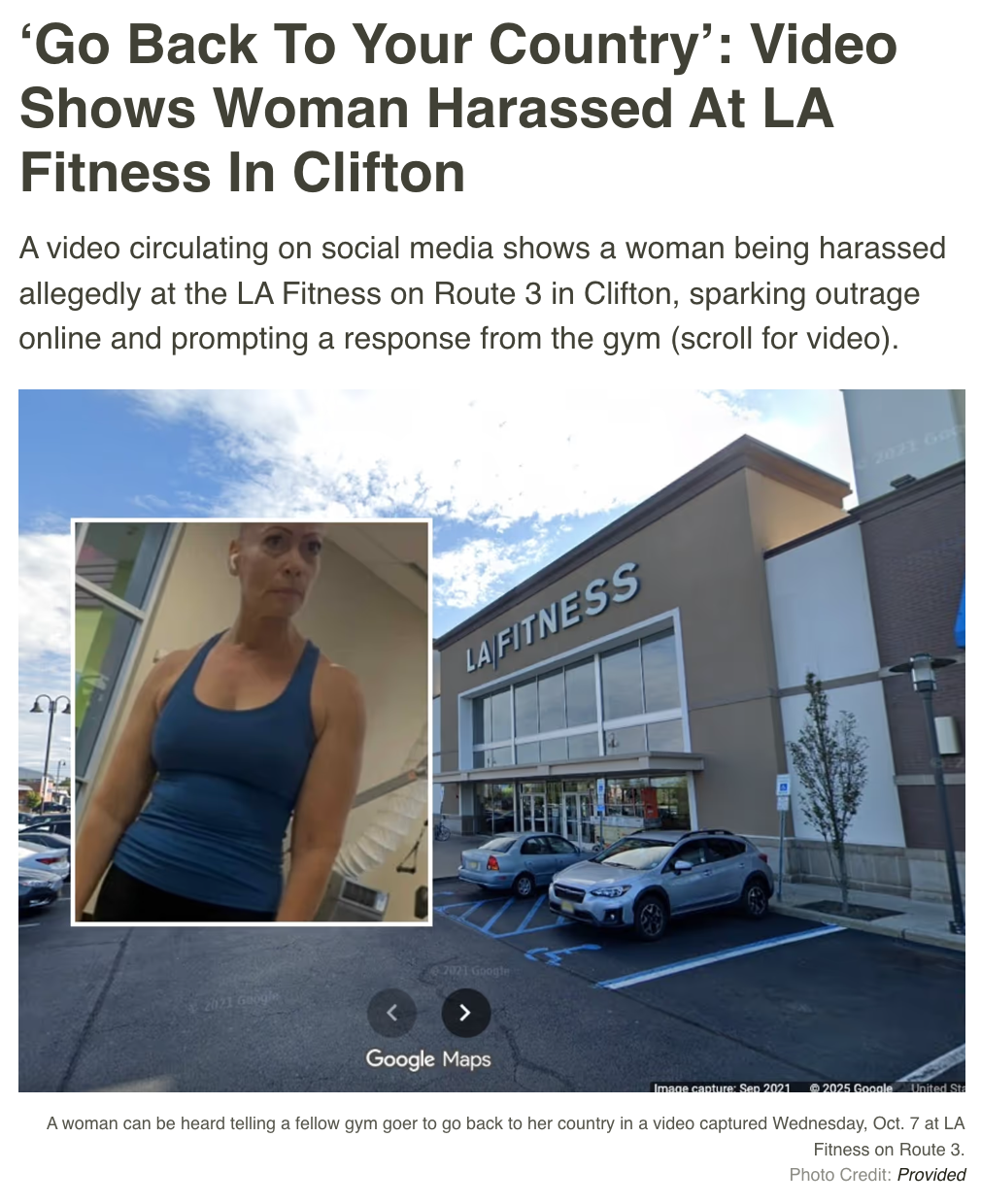
Source: Daily Voice
One such article features a headline that exemplifies the balanced reporting Daily Voice is known for. Two photos appear stacked vertically, accompanied by a gray caption explaining their context. The article begins neutrally, starting to explain what occurred. In this situation, one woman at a gym deliberately spoke demeaningly to another woman, telling her that she should “go back to her country”. This form of writing is likely to resonate with their audience, who look for unbiased writing and clear explanations.
Reporter Cecilia Levine outlines the situation without incorporating her own opinion. For instance, there are primary sources from the victim herself and from LA Fitness, which issued a statement apologizing to the victim. This lends weight to the article and backs up Levine’s explanations with sufficient evidence to prove her writing true.
“The victim said LA Fitness’ district manager called her that day issuing an apology and seeking additional information. As of press time, it wasn’t immediately clear if the assailant’s membership had been revoked.”
The article does not lean toward either political party. By using the headline and the primary sources covered, Levine maintains neutrality and proceeds only to explain the incident. There is a lack of framing, and the article does not cater to any particular group of people, even if there may be readers who supported or disliked the victim’s detailing of the dilemma.
By contrast, another article titled “Matthew Dowd Out At MSNBC Following Controversial Remarks On Charlie Kirk” contains a slightly more biased perspective. It lays out the situation clearly, but Reporter Joe Lombardi’s opinion bleeds through briefly in certain parts of the article. Phrases and diction like “during coverage of the shooting,” and “Dowd later apologized” reinforce the article’s bias, which agrees with Daily Voice’s overall bias rating. Hot-button issues like Dowd’s removal are presented factually, without spin:
“Minutes earlier on Wednesday, Sept. 10, MSNBC President Rebecca Kutler issued this statement on social media: “During our breaking news coverage of the shooting of Charlie Kirk, Matthew Dowd made comments that were inappropriate, insensitive, and unacceptable. We apologize for his statements. There is no place for violence in America, political or otherwise.”
The article employs notably restrained and formal language, though its bias rating is slightly higher than for other Daily Voice articles. The language used is informative but slightly right-leaning, conveying the dynamics seen within the reporting of Dowd’s penalty. The author also occasionally uses language that could be seen as moderately in favor of Dowd’s public calling out. While the tone frequently remains even-handed, certain words or the way the quotes are presented may agree with MSNBC’s opinion on Dowd’s statements.
To sum it up, Daily Voice shows rather consistent bias throughout its reporting. While Levine’s coverage of the woman, degraded at an LA Fitness gym, maintains neutrality through balanced presentation and restrained language, the Matthew Dowd article reveals a small conservative slant by framing MSNBC’s decision to part ways with Matthew Dowd as a positive one. Despite occasional lapses, Daily Voice’s tendency to maintain opinion out of its articles indicates an overall close to center position when covering a broad range of topics.
Analysis of Daily Voice Opinion Articles
To fully understand political bias in media, it’s important to distinguish between factual reporting and opinion pieces. While reporting aims to present facts and let readers form their own conclusions, opinion articles express personal viewpoints on current issues. Although the previous section examined factual reporting, this section turns to how bias surfaces through Daily Voice’s selection and tone of opinion content.
As shown previously throughout this article, Daily Voice has a long-standing commitment to presenting unbiased news. Naturally, there are some articles that will skew more than others, even if Daily Voice’s tendency is to provide clear news. One prominent example is the report titled “Undocumented Immigrant Drove 18-Wheeler Using New York License Issued To ‘No Name’: ICE”. The title itself does not favor any particular political party, but putting the story directly on the front page may. This framing may imply a right-leaning tilt, consistent with Daily Voice’s overall rating, according to Biasly’s bias report – suggesting that the editor’s decision to phrase the headline as such and provide photos of the immigrant’s license was a strategic decision.
In contrast, another piece titled “Trump Escalates Trade Fight, Threatening 100% Tariffs On Chinese Imports: Markets Tumble” employs more centrist language. Its title does not lean toward any political side and frames the issue only around what Donald Trump and Xi Jinping have said about the tariffs. The article is neutral and avoids emotionally loaded language, indicating that the piece may be less ideologically charged.
These examples indicate that while most Daily Voice opinion pieces remain balanced, some align with conservative-leaning narratives. The consistency with which Daily Voice remains unbiased may be a reason for its high monthly viewership and user trust.
This tendency underscores the importance of distinguishing subjective viewpoints from straight reporting, especially when interpreting the political leanings of any news organization.
Who Owns Daily Voice?
Daily Voice operates under a business model that brings in revenue from advertisements on the platform. It is owned by Cantata Media LLC, and led by three key executives. As of 2025, the President is Ted Yang, the CEO is Travis Hardman, and the General Counsel is Larry Andrea.
Under its current structure, the newspaper’s editorial board operates independently of its newsroom and is not permitted to endorse political candidates or publish opinion articles. Daily Voice’s policy asserts:
“We are apolitical, non-partisan, and as fair and complete as possible. Readers know we don’t take sides. We do not publish editorials or opinion pieces, nor do we endorse political candidates.”
This reinforces the paper’s public commitment to transparency in journalism, helping ensure that financial contributions do not bias editorial content. While some bias may still arise from staff perspectives or editorial practices, it is unlikely to be tied to external funding.
This approach may provide added reassurance to readers seeking a news outlet that values independence and editorial integrity.
How to Evaluate Bias
Although Biasly rates Daily Voice as Somewhat Right, it’s important to remember that bias can vary from article to article. Daily Voice covers a very liberal-leaning area of the United States with objectivity on many issues, from state legislation to social developments. This complexity underscores the importance of examining each article individually. So, let’s learn how to evaluate media bias.
Recognizing media bias requires awareness and critical thinking. Often, readers trust news sources that affirm their existing beliefs, a psychological tendency known as confirmation bias. This makes it harder to identify slanted narratives or one-sided reporting.
To combat this, it’s essential to challenge your assumptions by consulting multiple viewpoints and verifying news through third-party analysis. Tools like Biasly’s media bias ratings allow readers to compare the same news story across the political spectrum.
Ultimately, bias isn’t always a matter of what is said, it’s also about what is left out, how topics are framed, and which stories are chosen for coverage. Learning to recognize these patterns can help readers make more informed decisions and develop greater media literacy.
To start comparing news outlets and gain a better understanding of bias, sign up for Biasly’s Media Bias & News Analytics Platform to see how stories vary between sources.
Daily Voice Reliability Analysis
Is Daily Voice Reliable?
Daily Voice falls near the middle of the reliability spectrum, showing neither exceptionally high nor low accuracy. Its status as a local news outlet contributes to its moderate reputation for reliability. According to Pew Research, Americans generally hold less politically polarized views toward local news compared to national media. In fact, 85% of adults regard local journalism as at least somewhat important to their community. However, another Pew study found that satisfaction with local political news coverage remains disproportionately low compared to its prominence.
Daily Voice’s popularity among New England readers may stem more from accessibility than from political coverage reliability. Further investigation is needed to determine whether bias or other factors are affecting its accuracy. At Biasly, we specialize in evaluating not just bias but also the reliability of media outlets. Let’s explore the accuracy and trustworthiness of Daily Voice.
How to Evaluate Reliability?
Reliability refers to how trustworthy or accurate a news source is. If we can’t trust what we read, then continuing to consume content from that outlet serves little purpose. So how do we evaluate a news outlet’s reliability?
There are several potential measures of reliability to look out for when trying to determine whether a media source is reliable or not. Red flags for an unreliable article can include the presence of wild, unsubstantiated claims, facts dependent on other unreliable sources, heavy use of opinionated language, and more. In contrast, hallmarks of a reliable source include:
- Absence of subjective language
- Citing credible sources (e.g., .gov, .edu, academic references)
- Verifiable facts and statistics from multiple outlets
- Use of primary sources, like interviews or transcripts
- Consistency with coverage across other platforms
Biasly’s reliability scores incorporate these elements in evaluating media outlets.
So How Does Daily Voice Fare in Its Reliability?
The political reliability index developed by Biasly assesses both accuracy and trustworthiness. Daily Voice currently holds Average Reliability Score, which is calculated as a weighted average of:
- Fact Analysis Score – Evaluates the accuracy of claims, facts, and evidence.
- Source Analysis Score – Assesses the number, diversity, and credibility of sources and quotes used.
Daily Voice’s Source Analysis Score is Average at 45% Reliable. This suggests moderate trustworthiness in its sourcing practices. The score is AI-generated and considers quote length, frequency, diversity, and quality.
The Fact Analysis Score is yet to be finalized. This score will further determine how well Daily Voice supports its claims, addresses selection and omission bias, and presents verifiable evidence. Until this is available, readers are encouraged to perform their own evaluations using Biasly’s media bias tools.
While Daily Voice leans toward factual reporting, occasional lapses, such as unbalanced viewpoints or incomplete data, can affect its reliability rating. These nuances emphasize the importance of analyzing individual articles.
Daily Voice’s Accuracy and Reliability
According to Biasly’s analysis, Daily Voice maintains Average Reliability Score, but individual articles may vary significantly. Let’s dive into the details.
Political orientation plays a crucial role in how audiences perceive reliability. Daily Voice has briefly been accused of harboring a slightly conservative sentiment, potentially at the expense of factual reporting. To validate such claims, it’s essential to analyze whether the publication backs its assertions with sufficient evidence and diverse viewpoints.
Two common types of bias that affect factuality include:
- Selection Bias – Highlighting or omitting stories to fit a particular narrative.
- Omission Bias – Leaving out differing perspectives or relevant details to skew perception.
Biasly’s accuracy ratings use a scale from 1% (least accurate) to 100% (most accurate). Factors include the presence of supporting evidence, internal and external reliable sources, and balanced viewpoints.
For instance, Biasly gave USA Today a Somewhat Liberal Bias and a Good Analyst Reliability Score. One USA Today article, titled “Government Shutdown Latest; IRS to furlough nearly half its staff; Senate rejects deals”, showed an Average reliability rating for failing to include diverse viewpoints and for employing inflammatory language. Critical language towards Donald Trump’s administration is a common theme throughout all of the article, and the several reporters who worked on this article failed to complement a selection of liberal opinions with views belonging to any other school of thought. In contrast, another piece from the outlet, titled “Luigi Mangione lawyers seek dismissal of federal death penalty charge” features legal and political sources with balanced quotes. The article is written in a manner that does not favor any particular side. An example is seen in this quote, where the situation is presented naturally:
“In court documents filed Oct. 10, Mangione’s lawyers argued that prosecutors should also be barred from using some statements that he made to police before he was arrested. They also included evidence found inside his backpack, including a gun and ammunition.”
We will take a closer look at more examples like this below to provide a further investigation into the reliability of Daily Voice’s articles. This will include its use of selection bias, omission bias, and the quality of its sources and the facts it uses.
Analysis of Reliability in Daily Voice’s Online News Articles
Daily Voice aims to serve New England states with objective, fact-based reporting. Its staff includes writers from varying ideological backgrounds, which can help balance coverage. However, readers should distinguish between news reporting and opinion pieces to evaluate credibility effectively.
One notable example is the article titled “‘Tried To Cancel Me’ Jimmy Kimmel Slams Trump In Triumphant Late Night Comeback.” Reporter Zak Failla covered Jimmy Kimmel’s return to his late-night show after a week of controversy due to comments about Charlie Kirk’s assassination. The article refrains from editorial commentary, sticking to quotes and informative language. This piece illustrates factual neutrality, further underscoring Daily Voice’s Somewhat Right.
Quality of Sources and Facts Used
Daily Voice often uses credible sources from across the political spectrum. However, some articles may skew in how comprehensively they present opposing viewpoints.
Consider the headline: “Plot To Cripple NYC Communications Thwarted Ahead Of Trump Address To The UN, Secret Service Says”. It is well-documented and supported by legal references, and does not lack any insight into the event that occurred. Daily Voice prides itself on being “apolitical” and writing only to inform. This article, along with its facts, demonstrates a dedication to that commitment.
An example of this comes through in this quote from the article:
“Electronic safe houses were discovered in a vacant apartment in Queens as well as in suburban areas north of New York City: at a business park in Armonk, New York, as well as Greenwich, Connecticut, and a location in northern New Jersey, according to CNN Chief Law Enforcement and Intelligence Analyst John Miller.”
Another example can be seen in the article “Nor’easter: Hochul Declares State Of Emergency For Long Island”, which maintains objectivity. It features multiple reputable weather reports, without any editorial slant. The author refrains from adding any personal opinion to the article and focuses only on stating clear, concise facts in a time of crisis. This allows readers to interpret the article in their own thoughts.
The article gains credibility through its 4 quotes from weather sources and the governor of New York, 3 long and 1 medium-length. These quotations strengthen reliability by providing full context and minimizing misrepresentation, offering readers a more authentic and trustworthy account from primary sources.
The article features two sources: a weather reporting news outlet and Kathy Hochul, the governor of New York. Both of these sources are trustworthy ones that the audience knows and can fact-check on their own time.
- Kathy Hochul, New York Governor
- Accuweather, Weather Reporting Company
The article accurately reflects the most up-to-date information on the Nor’easter and informs residents on how to prepare themselves. There is a lack of bias and of any controversial statements, which adds to the audience’s trust in Daily Voice.
The article primarily relies on primary sources, which are highly valid and enhance its reliability. Given its focus on the potential effects of the Nor’easter and what people in New England states may do to prepare, including statements from the governor herself, adds a sense of security to the article.
Selection and Omission Bias
Daily Voice provides extensive coverage of problems and citizens’ concerns in New England states, which is reasonable given that its primary audience is based there. However, bias may still emerge through framing and story selection.
In “Slain Israeli Embassy Staffers Were About To Get Engaged: Report”, selection bias surfaces through the article’s emphasis on a right-wing point of view in the sources used. The article only focuses on those condemning the murder, even if there may have been people who were in agreement with Elias Rodriguez, the perpetrator, who murdered them. The article does not explore differing points of view when it comes to the lives taken.
The article does not highlight or add any proactive or positive measures taken by the Israeli embassy in recent years. It also does not add any negative ones, even if the undercurrent of the article is mourning the two staffers who were fatally shot. Therefore, the article leans slightly right in its framing. The author only uses social media posts from those who were vehemently against the murder, and does not go into detail about other perspectives. That said, the reporting does not cross into overt editorializing and is still grounded in verifiable facts and quotes for the most part.
By comparison, the article “Student With Autism Sues NY University After AI Cheating Accusation” shows a stronger balance. Reporter Michael Mashburn includes quotes from the Professor, the student, and the filed lawsuit. A notable example of unbiased writing comes from the following quote:
“The dispute began in November 2024, when Newby’s professor accused him of submitting AI-generated work. The professor cited a Turnitin report allegedly showing a “100% AI score,” according to the complaint.”
Mashburn uses a number of sources that display diversity of opinion when brought together. The article incorporates perspectives from both sides, presenting facts that allow readers to form their own conclusions. Overall, Mashburn used a well-rounded approach to delivering unbiased news to readers of Daily Voice.
In opinion pieces, issues with factuality, sources, selection, and omission are frequently present. The articles we’ve covered so far reflect Daily Voice’s Somewhat Right views, but this is not detrimental to its reliability. Its story selection may sometimes favor issues that are more concerning to conservative audiences, but there tends to be a good balance of articles that do not include any bias at all. The contents of Daily Voice’s article maintain accuracy and tend to cite evidence from numerous and varied sources.
So, Is Daily Voice Reliable?
Overall, Daily Voice can be considered to be an outlet that is moderately reliable. It demonstrates a drive to maintain its articles without any bias, but variable sources and occasional editorial framing on sensitive topics may affect its rating. While some claims are supported with evidence, consistency in sourcing and balance could be improved to meet stronger journalistic standards.
As media literacy improves, readers can more easily detect issues with selection bias, omission bias, and factuality. To strengthen your ability to assess reliability across the political spectrum, use the News Bias Checker to compare how multiple outlets report the same story.
This empowers you to consume more accurate, balanced, and dependable news.
Additional Insights
News Source Comparison
When it comes to news source comparison, Daily Voice is often evaluated alongside other regional and national outlets that lean right or center-right. Sources like Forbes, Wall Street Journal, or the New York Post often present similar tones and editorial philosophies. While Daily Voice maintains a Somewhat Right media bias, it differs from strongly partisan sources in that it occasionally includes opposing viewpoints and strives for regional coverage balance.
This puts it in contrast with more biased media outlets that present consistently one-sided narratives without factual counterpoints. Readers seeking balanced political coverage may compare Daily Voice’s framing of issues with outlets rated as Center or Lean Right on our Media Bias Chart, or explore other regional papers on our Similar Sources page.
Notable Contributors and Authors
Daily Voice features a diverse range of reporters and columnists, many of whom are deeply familiar with the New England states’ political and social climate. Reporters like Zak Failla, who frequently cover political controversies and incidents in hyper-specific regions, exemplify the outlet’s strength in local investigative journalism.
Other contributors focus on politics, business, and regional issues, topics central to New England communities. While some contributors may be seen as leaning right in tone or topic selection, their work is generally grounded in factual reporting. The presence of recurring bylines helps readers evaluate individual journalists’ bias over time.
Related Tools and Resource Pages
To better understand how Daily Voice fits into the broader media landscape, we recommend exploring these helpful resources:
- Media Bias Chart: See where Daily Voice ranks among hundreds of media outlets across the political spectrum.
- Political Bias Chart: Visualize political slants of news sources across various policy areas.
- Journalist Bias Analytics Platform: Explore how individual journalists contribute to bias within their publications.
- Politician Bias Analytics Platform: Compare how politicians are framed differently by Daily Voice and other outlets.
- Media Literacy Education Platform: Learn how to critically assess media sources, bias techniques, and news reliability.
Frequently Asked Questions
Daily Voice is rated as Somewhat Right based on Biasly’s media bias algorithm, which assesses sentiment, article framing, and policy favorability.
While Daily Voice is not widely known for promoting fake news, one of its primary commitments is to remain unbiased. Its factual reporting is generally sound.
Biasly uses a combination of AI sentiment analysis and human analyst review to assess tone, fact accuracy, source quality, and media bias indicators. Learn more on our Bias Meter page.
Yes, but with caution. Daily Voice typically upholds fact-based journalism, though occasional partisan framing and selective reporting may impact overall news reliability.
Ratings are based on recent news using data science and A.I. technology.
Military Spending
| Date | Sentiment | Associated Article | Snippet |
|---|---|---|---|
| 08/25/2019 | 75% For | Trump Family Detentions Flores Agreement (link) | So, of course, the Trump administration is doing the opposite in a baldfaced |


























